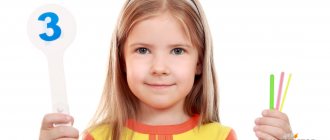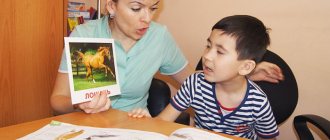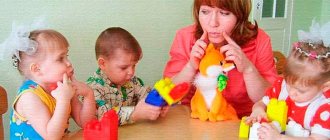- home
- Speech development
Scientists have proven that geniuses are not born, they are made. Becoming a genius in your child is a long and not easy process. The early period of development requires a lot of time, attention, and love. You can’t do without knowledge of techniques. The “Colored Numbers” technique, developed at the beginning of the 20th century by the teacher and scientist from Belgium George Cuisenaire, is a help to all mothers and early childhood educators. His ideas are consistent with the concept of early development, which was put forward by the Russian teacher innovator B.P. Nikitin.
Methodology
What new will the child learn, what skills will the Cuisenaire rods develop in him? Here is a small list of what a child can do thanks to them:
- quickly learn colors;
- will understand the concepts of “short”, “long”, “high”, “low”;
- will develop fine motor skills, thinking, imagination;
- will get an idea of the categories “part”, “whole”, “more”, “less”;
- master construction using a logical approach;
- solve your first mathematical examples, mathematics will become an exciting science.
What do cubes develop?
Dienesh's logic cubes in an accessible and visual form introduce children to colors, shapes, sizes, thickness of objects, basic knowledge of mathematics and the basics of computer science. The child will learn all this by playing and performing various manipulations with blocks: laying out, breaking, rebuilding according to a given pattern, etc.
The set develops:
- creative potential;
- logical thinking;
- mental operations (classification, comparison, analysis, generalization);
- cognitive processes (sensation, perception, attention, memory, imagination);
- fine motor skills.
Description of the kit
Cuisenaire sticks are a set of 116 sticks of different colors and lengths. Total 10 colors: white, pink, blue, red, yellow, purple, black, burgundy, blue, orange.
Each color corresponds to a length. The white stick is the shortest, it is a cube 1 cm long, the orange one is the longest - 10 cm.
The table shows that all colors form three families + white, black (neutral) colors. Orange and purple are present in two families, as they appeared due to the mixing of these colors.
In addition, the numbers encrypted in the red family are divisible by two, in the blue family by three, and in the yellow family by five.
| Red family | Blue family | Yellow family |
| Pink | Blue | Yellow |
| Red | Blue | Orange |
| Burgundy | Violet | |
| Orange | ||
| Violet |
In addition to the Cuisenaire counting sticks themselves, the set contains mathematical signs for basic operations, as well as numbers from 1 to 20. For children who have already mastered “color counting”, classic examples can be used, like at school. Also included are instructions for use.
The material used for the “color count” is lightweight, smooth, and made from certified plastic. They are excellent counting material. Cardboard numbers and signs. This workbook helps you do addition, subtraction, multiplication, and division.
Games with Cuisenaire sticks for children from 5 to 9 years old
For older children, such aids as:
- A set of games “On the Golden Porch” for children from 3 to 9 years old.
- Set of games “China shop. Krostiki" for children from 5 to 8 years old.
With the help of these kits, children will easily get acquainted with the principle of coloring sticks, with the relationships of color - length - number; will be able to recognize a pattern and lay out sticks in accordance with it; will be able to lay out (reproduce) an object along its contour, master the operations of “decoding” images; get acquainted with symmetry; learn to navigate on a plane and work with a coordinate system.
- Once upon a time there were colorful sticks. They were in a tight box. And then one day, when all the sticks were poured out of the box, they decided to build themselves colorful houses and live there as families.
- Anya, let's cast a spell on the little kitten and put it out of sticks.
Interesting cards are cards with tasks that allow you to independently lay out an image according to a diagram.
Tasks of increased complexity include cards with image content encoded in numbers. The young player needs to “decode” this image and build it using sticks.
An excellent tool is the mathematical game “China Shop. Krostiki" for children from 5 to 8 years old. In this manual, children are offered tasks to design in a coordinate system. At first, completing tasks of this level of complexity was too much for even my eldest 8-year-old daughter Masha.
Purposes of use
There are parents who are afraid that it is too early to load their child with mathematics. Educators agree that it is better to worry about it not being too late. Sensitive periods in development do not last so long; we cannot know for sure about their timing. They pass very quickly; will the child have time to master the necessary skill during this period? Therefore, it is better to offer your child tasks in his zone of proximal development. It may be difficult for now, but when his brain is ready, he will cope with the task, to the surprise of you and those around him.
Here are the main reasons why teachers all over the world actively use Cuisenaire colored counting sticks in their teaching practice:
- Using the clarity of mathematical operations, which allows you to work with young children.
- Development of fantasy and imagination. The number of tasks with this tool tends to infinity.
- Fine motor skills develop, as the fingers are involved in the work.
- Science turns into an exciting game, which means it is easier for children to perceive and assimilate. Oral counting is easy.
- Helps in developing related skills and teaching writing. You can build with them like a construction set, lay out words, and assemble labyrinths.
- Allows you to measure the lengths of other objects, since the length of each color module in centimeters is known in advance.
- Makes it possible to consolidate the understanding of geometric shapes by drawing up their contours.
- Forms a sustainable interest in knowledge, including mathematical science.
Conclusion
Thousands of families successfully use Cuisenaire rods in teaching their children. A description of the methodology for their use helps such parents to use them effectively. While playing, the child will be able to learn the basic mechanisms of counting without much effort and tension. This simple method allows you to bring significant variety to your child’s learning.
How can you personally use Cuisenaire wands effectively? The description of the technique given in this article will help you teach your child something new. Go ahead, the result will not keep you waiting long.
From what age
Cuisenaire sticks, as well as Dienesh blocks, can be used even earlier than indicated on the box. The author himself suggested starting classes from 1 year. Experienced teachers recommend starting classes at the age of 2, under the mandatory supervision of parents. In fact, without their participation, the educational and gaming process will not work. As the child grows up, gaming tasks become more complex.
The largest number of tasks is provided for ages 3–4 years. Middle age, preschoolers (5-6 years old) are capable of solving more serious educational problems. Even older children, primary school students (7-9 years old) find these activities interesting.
Advantages and disadvantages
There are many positive aspects, below are some of them:
- There are many options on how to develop fine motor skills, thinking, and imagination;
- Formation of conscious attention, perseverance;
- Memory training, reactions;
- The ability to use one teaching material for children of different age groups, changing only the wording of the tasks themselves;
- Children acquire the skill of finding solutions independently.
Scientists could not find any disadvantages as such. Some sources indicate that the disadvantage is the need for the presence of an adult, since when playing independently, children quickly lose interest in such a game. We can say that all upbringing and training requires the participation of adults, so this minus should not be taken into account.
To achieve maximum results, you need to work with your child systematically. Proper encouragement and a variety of activities will also help in quickly mastering the basics of mathematics.
Positive reviews
Parents love to use Cuisenaire sticks in teaching their children. Here are the positive aspects of this product they highlight:
- unlimited shelf life;
- replaces many other games;
- develops logic, fine motor skills, perception and concentration;
- allow you to actively develop the child’s cognitive activity;
- the concept of the composition of words is laid for children who have not yet read;
- It's easy to teach your baby to count using visual, auditory and tactile methods.
If you are also impressed by such benefits, we recommend that you consider purchasing such a wonderful teaching aid.
Similarities and differences with Dienes blocks
Often, Cuisenaire sticks and Dienesh blocks stand side by side among early development techniques. This is no coincidence; they are somewhat similar. Both methods use visual and effective material, train logical thinking, and develop imagination. They are multifunctional, aimed at children of different ages, and easy to learn.
The difference between Dienesh blocks is the additional parameter of differences in materials in thickness (thin and thick) and in shape (circle, triangle, square). In Cuisenaire's colored rods there is a difference in length in centimeters, as well as a larger number of colors. They have the opportunity to create examples from numbers using mathematical symbols, illustrating them with examples of “color counting”.
Dienesh blocks and Cuisenaire sticks are techniques that represent demonstration material; they do not contradict each other, but complement each other perfectly. You can use these two sets together. This will allow you to further diversify your classes by coming up with new and interesting tasks. An innovative approach to education calls for teaching through play so that information is remembered easily and naturally.
A little history
The manual attracts children not only with its versatility, but also with its bright design.
A mathematical manual (1952) by the Belgian mathematician George Cuisenaire is based on the visual-tactile mastery of abstract concepts such as set, order and identity. By the way, we owe the popularization of the manual to Cuisenaire’s colleague, the French mathematician and philosopher Caleb Gatenot, who began to use the “numbers in color” manual (“counting sticks”, “colored rulers”, “colored sticks”, “Cuisenaire sticks”) when studying mathematics and language.
Games
For children in kindergarten, preschoolers and schoolchildren, various games with Cuisenaire sticks have been developed, from the simplest to the more complex.
Games for kids 1 – 2 years old
Children can only work with this manual under adult supervision, as there are small parts. Home comfort and familiar surroundings contribute to the development of new activities. Already at one year old, children can play with them, look at colors, and the adult’s task is to give comments about length, color, height, quantity.
"Builder". Invite your child to look at the building materials, take as many blocks as possible in one hand, then transfer them to the other. So the child's hand will begin to feel the difference in size and quantity. Build a road, house, bridge, tree, well, transport with your child.
"Sorter." You can take colored cardboard and invite your child to sort the sticks by color. You need to put all the red ones on the red sheet, and all the yellow ones on the yellow sheet.
"Up the stairs." Assemble the ladder from the white to the yellow stick. Take a small toy, such as a bunny, and let him jump up the stairs. At the same time, count “The bunny jumps again, one, two, three, four, five.” Then you can assemble a ladder higher, and count to 10. When the child has mastered this game, you can skip the steps (the ladder is broken) so that the child puts them in place (repairs the ladder).
"Do as I do". Show the child a blue stick in your hand and ask him to take the same one. Take two sticks and have him repeat. Make the roof of the house out of them. The essence of the game is that the child learns to correlate what you show and do the same. You can hum a song before each new demonstration and repetition, “trawl-la-la, trawl-la-la, do Mishenka (your child’s name) like me!” You can use the mirror method on paper. An image is drawn on one half, and the child must complete the second half using a template.
"Colored fence" Lay out two colored sticks, then again two of the same. Say that you are painting the fence blue and orange, and invite your child to continue the fence. Then you can complicate it by adding a number of colors, building more complex sequences. For example, blue, white, pink, yellow. Let the child post more.
"Elusive." Play with the sticks as if they were living characters, say that now they will run away, change places, hide. Lay out five sticks, and then, while playing with them, hide one behind your back or next to the box. Ask your child which stick disappeared? Where did she go? Let him find her. You can also swap them, red was the first. Place it in the middle. Where did she go? This game develops attentiveness and trains memory.
"Train". Build a train with carriages of different lengths using sticks. Name colors and sizes. Ask which carriage is the longest, what does it carry? Maybe logs for the house. What is the smallest carriage that can carry? Maybe apples. How many cars are there at the station? How many have gone, how many are left? During this game, the child learns the concepts of “long”, “short”, “big”, “small”, “one”, “many”. To complicate the game, you can ask which car is to the right of the red one, to the left of the yellow one.
Dienesh's cubes: tasks for older children
Game "Carry On"
The adult lays out several cubes with one identical characteristic and asks the child to make the second row according to the pattern. For example, we take color as a sign: blue square, red circle, yellow triangle. The kid must keep this sequence of colors and lay out a row. For example: blue triangle, red square, yellow circle.
Game "Hide and Seek"
Lay out several cubes in front of the baby and tell him that a kitten is hiding under one of them (a picture with his image). You can find it by asking leading questions. For example: “Is this a square cube?”, “Is this a yellow cube?” Give your child an example to make it clearer.
Game "Sorting"
It is useful to teach your child to clean from an early age. How? Usually the child is asked to help put the toys back in place. This can be successfully used when, after class, you need to remove the Dienesh cubes. Reviews from parents say that children are happy to help adults if they get used to it in time.
Divide the work with your child, tell him that let him collect all the yellow and small cubes, and you do the rest.







